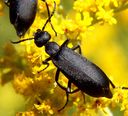Epicautini
Epicautini
Classification
- Phylum: Arthropoda
- Subphylum: Hexapoda
- Class: Insecta
- Order: Coleoptera
- Suborder: Polyphaga
- Superfamily: Tenebrionoidea
- Family: Meloidae
- Subfamily: Meloinae
- Tribe: Epicautini
Pronunciation
How to pronounce Epicautini: /ˌɛpɪˈkaʊtɪnaɪ/
These audio files are automatically generated. While they are not always 100% accurate, they are a good starting point.
Images






Summary
The Epicautini tribe consists of blister beetles known for their toxicity due to the secretion of cantharidin, with a unique hypermetamorphic life cycle. They play roles in pollination and pest control but pose significant risks to livestock if ingested.
Physical Characteristics
Aposematically colored with some species exhibiting bright colors to signal toxicity. They are hypermetamorphic and the first larval stage is typically a mobile triungulin.
Identification Tips
Look for bright-colored beetles often found on flowers. Their distinct coloration can help in identifying toxic species.
Habitat
Commonly found in areas where their food sources (bees, grasshopper eggs) are present; often in flowering plants and fields, especially alfalfa fields.
Distribution
Approximately 180 species in the described area and close to 300 in the New World; widespread in various regions globally.
Diet
Adults feed on flowers and leaves from various plant families including Amaranthaceae, Asteraceae, Fabaceae, and Solanaceae. Larvae are insectivorous, targeting mainly bees and occasionally grasshopper eggs.
Life Cycle
Undergo hypermetamorphic development with several larval stages, beginning with a mobile triungulin kept in motion by other insects, which are frequently bees.
Reproduction
Females lay eggs in proximity to host species; larvae can survive on provisions provided by their hosts if necessary.
Predators
Predators include birds and other insects; however, due to their toxic nature, many predators may avoid them.
Ecosystem Role
Act as both pest and predator; larvae can reduce bee populations and help in controlling certain insect populations while adults help in pollination.
Economic Impact
Potentially lethal to horses if consumed alongside contaminated forage; can impact alfalfa production and pest management practices.
Cultural Significance
Historically used in folk medicine for the extraction of cantharidin, referred to as 'Spanish fly'.
Health Concerns
Cantharidin is a potent blistering agent; ingestion can lead to serious health consequences in mammals, including toxicity in horses.
Evolution
Family Meloidae began diversifying during the Early Cretaceous; notable for a long evolutionary history with the oldest known fossil dated to around 99 million years ago.
Misconceptions
Some may confuse blister beetles with harmless insects due to their bright coloration, not realizing their potential toxicity.
Tags
- beetles
- blister beetles
- Epicautini
- cantharidin
- toxic insects